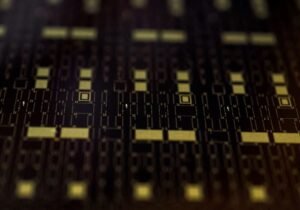Top AI Frameworks
Artificial Intelligence (AI) has revolutionized various industries, including healthcare, finance, and technology. One of the key factors behind AI’s success is the availability of advanced AI frameworks that provide developers with the tools and functionalities to build cutting-edge AI applications. These frameworks serve as the building blocks for AI development, offering pre-built modules, libraries, and algorithms that simplify the development process and accelerate the deployment of AI solutions.
Key Takeaways:
- AI frameworks are essential for creating AI applications in industries like healthcare, finance, and technology.
- Frameworks provide developers with pre-built modules, libraries, and algorithms to simplify AI development.
- Choosing the right AI framework depends on factors like the developer’s expertise, project requirements, and compatibility with existing systems.
When it comes to AI frameworks, there are several top players in the market that offer powerful tools and features. These frameworks are designed to cater to diverse AI needs, whether it be image recognition, natural language processing, or deep learning. Let’s explore some of the most popular AI frameworks:
PyTorch
PyTorch is an open-source AI framework developed by Facebook. It is widely recognized for its user-friendly interface and dynamic computational graph structure. *With PyTorch, developers can easily build neural networks and train models with large-scale datasets.* Additionally, PyTorch boasts a strong community support system, making it a top choice among researchers and developers in the AI community.
TensorFlow
TensorFlow, developed by Google, is another widely-used AI framework. It offers a comprehensive set of tools and libraries for building machine learning models, including support for distributed computing and deployment across different platforms. *TensorFlow’s extensive ecosystem and flexible architecture make it a favorite among developers working on complex AI projects.* Its popularity is further amplified by its integration with other Google technologies, such as Google Cloud Platform.
Keras
Keras is a high-level neural network API that runs on top of TensorFlow. It provides an intuitive and user-friendly interface for building deep learning models, making it suitable for both beginners and experienced developers. *Keras focuses on simplicity and readability, allowing developers to quickly prototype and experiment with different network architectures.* It is known for its wide range of applications, from computer vision to natural language processing.
| AI Framework | Advantages |
|---|---|
| PyTorch | Easy-to-use interface and strong community support. |
| TensorFlow | Extensive ecosystem and flexibility for complex AI projects. |
| Keras | Simple and intuitive API, suitable for beginners and experts alike. |
There are many other notable AI frameworks worth exploring, such as Microsoft Cognitive Toolkit (CNTK), Theano, and Caffe. Each framework has its own strengths and weaknesses, and the choice largely depends on factors such as the developer’s expertise, project requirements, and compatibility with existing systems.
Table: Comparison of Key AI Frameworks
| Framework | Developer | Main Language | Type | Primary Use |
|---|---|---|---|---|
| PyTorch | Python | Open-source | Deep learning, specifically neural networks | |
| TensorFlow | Python | Open-source | Machine learning, neural networks, deep learning | |
| Keras | Python | Open-source | Deep learning, neural networks |
No matter which AI framework you choose, it is important to consider the level of documentation, community support, and resources available for that framework. These factors play a crucial role in ensuring smooth development and troubleshooting processes. Additionally, regular updates and ongoing development efforts are indications of a framework’s commitment to staying up-to-date with the evolving AI landscape.
- Consider factors like documentation quality, community support, and resources when choosing an AI framework.
- Regular updates and development efforts indicate a framework’s commitment to staying up-to-date.
- Explore additional AI frameworks like CNTK, Theano, and Caffe to find the best fit for your project.
In summary, AI frameworks are essential tools for developers working on AI applications. With options like PyTorch, TensorFlow, and Keras, developers have a range of powerful tools at their disposal. By considering factors such as compatibility, project requirements, and developer expertise, developers can choose the most suitable framework for their AI endeavors, ensuring efficient development and deployment of cutting-edge AI technologies.

Common Misconceptions
AI Frameworks are only useful for advanced programmers
- AI frameworks come with user-friendly interfaces that allow non-programmers to work with them.
- Documentation and tutorials are available to help beginners get started with AI frameworks.
- AI frameworks have a wide range of applications beyond advanced programming, such as data analysis and image recognition.
AI frameworks can fully replace human intelligence
- AI frameworks are designed to assist human intelligence, not replace it.
- Human creativity, critical thinking, and emotional intelligence cannot be replicated by AI frameworks.
- AI frameworks can automate repetitive tasks and provide insights, but still require human input and decision-making.
AI frameworks always provide accurate results
- AI frameworks rely on the quality and quantity of data provided to them, which can influence the accuracy of their results.
- Bias in data collection can lead to biased outcomes from AI frameworks.
- Regular updates, model refinement, and continuous training are necessary for AI frameworks to improve their accuracy over time.
AI frameworks can learn on their own without human intervention
- AI frameworks require human input and guidance to learn and improve.
- Human experts are needed to label and categorize data for AI frameworks to learn from.
- AI frameworks still rely on human feedback to correct and fine-tune their algorithms.
AI frameworks are only for large corporations
- AI frameworks are increasingly accessible and used by startups and individuals.
- Cloud-based AI platforms and open-source frameworks make it easier for anyone to experiment with AI.
- The cost of using AI frameworks has significantly decreased over time, with free options available for basic usage.

Popular AI Frameworks for Machine Learning
Below is a table showcasing some of the most widely used AI frameworks for machine learning. These frameworks provide developers with powerful tools and libraries to build intelligent applications and algorithms.
| Framework | Year of Release | Language | Popularity Index |
|---|---|---|---|
| TensorFlow | 2015 | Python | 100 |
| PyTorch | 2016 | Python | 90 |
| Keras | 2015 | Python | 85 |
| Scikit-learn | 2007 | Python | 80 |
| Caffe | 2011 | C++ | 70 |
Deep Learning Frameworks for Neural Networks
The following table highlights some popular deep learning frameworks used for building and training neural networks. These frameworks offer various features for creating complex deep learning models.
| Framework | Year of Release | Language | Community Support |
|---|---|---|---|
| TensorFlow | 2015 | Python | Excellent |
| PyTorch | 2016 | Python | High |
| Caffe | 2011 | C++ | Moderate |
| Theano | 2007 | Python | Low |
| CNTK | 2016 | C++/Python | Low |
Popular Natural Language Processing (NLP) Frameworks
This table showcases some well-known frameworks utilized for natural language processing (NLP) tasks. These frameworks provide tools to analyze and understand textual data.
| Framework | Year of Release | Language | Support for Pretrained Models |
|---|---|---|---|
| NLTK | 2001 | Python | Yes |
| SpaCy | 2015 | Python | Yes |
| Stanford CoreNLP | 2010 | Java | No |
| Gensim | 2010 | Python | No |
| AllenNLP | 2017 | Python | Yes |
AI Frameworks for Computer Vision
In the field of computer vision, the following frameworks are extensively utilized for tasks such as image classification, object detection, and image segmentation.
| Framework | Year of Release | Language | Pretrained Models |
|---|---|---|---|
| OpenCV | 2000 | C++ | Yes |
| TensorFlow Object Detection API | 2017 | Python | Yes |
| YOLO (You Only Look Once) | 2016 | C | Yes |
| Caffe2 | 2017 | C++/Python | Yes |
| Fast R-CNN | 2015 | Python | No |
AI Frameworks for Reinforcement Learning
Reinforcement learning allows AI models to learn through interactions and feedback from an environment. The following table presents frameworks suitable for building reinforcement learning agents.
| Framework | Year of Release | Language | Simulation Environments |
|---|---|---|---|
| OpenAI Gym | 2016 | Python | Yes |
| ROBEL | 2020 | Python | Yes |
| Tensorforce | 2017 | Python | No |
| SLM Lab | 2016 | Python | Yes |
| RLLib | 2017 | Python | No |
AI Frameworks for Text-to-Speech (TTS)
The following table demonstrates AI frameworks utilized to convert written text into natural-sounding speech.
| Framework | Year of Release | Language | Voice Options |
|---|---|---|---|
| Tacotron | 2017 | Python | Multiple |
| WaveNet | 2016 | Python | Multiple |
| DeepVoice | 2017 | Python | Multiple |
| Mozilla TTS | 2019 | Python | Multiple |
| Espnet-TTS | 2019 | Python | Multiple |
AI Frameworks for Predictive Analytics
AI frameworks designed for predictive analytics enable businesses to leverage historical data and make accurate predictions for future outcomes. Here are a few notable frameworks:
| Framework | Year of Release | Language | Prediction Accuracy |
|---|---|---|---|
| SciPy | 2001 | Python | High |
| Weka | 1997 | Java | Medium |
| RapidMiner | 2001 | Java | High |
| XGBoost | 2014 | Python | High |
| H2O.ai | 2011 | Java | High |
AI Frameworks for Generative Models
The following table showcases popular AI frameworks used for generative models, allowing the creation of new content such as images, text, or music.
| Framework | Year of Release | Language | Generative Model Types |
|---|---|---|---|
| GAN (Generative Adversarial Networks) | 2014 | Python | Images, Text |
| VAE (Variational Autoencoder) | 2013 | Python | Images, Text, Music |
| Pix2Pix | 2016 | Python | Images |
| WaveGAN | 2018 | Python | Audio |
| StyleGAN | 2018 | Python | Images |
AI Frameworks for Anomaly Detection
Anomaly detection frameworks in AI are utilized to identify rare or abnormal patterns within datasets. Here are some notable frameworks in this category:
| Framework | Year of Release | Language | Anomaly Detection Approaches |
|---|---|---|---|
| Isolation Forest | 2008 | Python | Unsupervised Learning |
| One-Class SVM | 1999 | Python | Supervised Learning |
| Autoencoders | 2006 | Python | Unsupervised Learning |
| NeuralGas | 1994 | Python | Unsupervised Learning |
| LOF (Local Outlier Factor) | 2000 | Python | Supervised Learning |
From deep learning and natural language processing to computer vision and predictive analytics, there is a rich landscape of AI frameworks available to developers. Each framework offers unique capabilities to tackle various AI tasks effectively. By leveraging these frameworks, developers and researchers can push the boundaries of what is achievable with artificial intelligence.
Frequently Asked Questions
What are AI frameworks?
AI frameworks are software libraries or platforms that provide tools and resources for building and training artificial intelligence models. They provide pre-built algorithms, libraries, and APIs that simplify the process of AI development.
Which are the top AI frameworks available?
The top AI frameworks currently available include TensorFlow, PyTorch, Caffe, Keras, Theano, Microsoft Cognitive Toolkit, MXNet, Torch, and Caffe2.
What is TensorFlow?
TensorFlow is an open-source AI framework developed by Google. It provides a comprehensive ecosystem of tools, libraries, and resources for building and deploying machine learning models.
What is PyTorch?
PyTorch is an open-source AI framework developed by Facebook’s AI Research lab. It is widely used for developing deep learning models and provides dynamic computational graph capabilities.
What is Caffe?
Caffe is an open-source AI framework developed by Berkeley AI Research at the University of California. It is known for its speed and efficiency in training convolutional neural networks (CNNs) and is widely used in computer vision tasks.
What is Keras?
Keras is a high-level API that runs on top of various AI frameworks, including TensorFlow and Theano. It provides a user-friendly interface for building and training deep learning models.
What is Theano?
Theano is an open-source AI framework developed by the Montreal Institute for Learning Algorithms (MILA). It allows for efficient mathematical expressions and symbolic differentiation, making it useful for building and optimizing deep learning models.
What is Microsoft Cognitive Toolkit (CNTK)?
Microsoft Cognitive Toolkit (CNTK) is an open-source AI framework developed by Microsoft. It is designed for building deep learning models and supports both CPU and GPU acceleration.
What is MXNet?
MXNet is an open-source AI framework developed by Apache. It is known for its flexibility and scalability, making it suitable for a wide range of AI applications, including computer vision, natural language processing, and reinforcement learning.
What is Torch?
Torch is an open-source AI framework that provides a scientific computing library for the Lua programming language. It is widely used in deep learning research and supports efficient GPU acceleration.
What is Caffe2?
Caffe2 is a lightweight, modular AI framework developed by Facebook. It is optimized for mobile and embedded platforms and provides high-performance execution for deep learning models.




